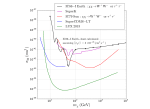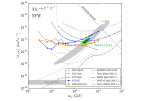The IceCube Collaboration has expanded dark matter studies with a search for annihilations in the center of the Earth. Researchers have used one year of data—May 2011 to May 2012—and have not found an excess of neutrinos above the expected background. The results have set new limits on the annihilation rate of WIMPs in the Earth that are an order of magnitude stronger than previous results by AMANDA and that also improve the IceCube spin-independent cross section limits for a WIMP mass of 50 GeV. This study has just been submitted to The European Physical Journal C. […]
Research
Exploring the possibility of detecting extragalactic supernovae with IceCube-Gen2, summer research with IceCube
Growing up on a small, secluded hobby farm in southwestern Wisconsin, the night sky played a major role in my upbringing. Since there is almost no light pollution, the night sky was always bright and clear. In the summer months, my bedtime was determined by the time a specific satellite went over the house. Every year, my family would gather up all the blankets in the house and lay outside to watch meteor showers for hours. From a young age, I loved the idea of learning more about the stars and planets, and as I got into high school, I fell in love with physics. My original plan was to become a high school physics teacher, and I found the University of Wisconsin–River Falls (UWRF) not only has a fantastic physics program but is also involved with IceCube. I had heard about IceCube in 2013, when it won Physics World’s Breakthrough of the Year, and working for IceCube became my new goal and dream. […]
Investigating excess of neutrinos from the galactic plane, summer research with IceCube
During my summer abroad, I worked with Dr. Jon Dumm, who is searching for an excess of neutrino events originating in the plane of the Milky Way. Dr. Dumm’s analysis is designed to look for a diffuse neutrino flux from the galactic plane in agreement with a map of where pion decay is expected to occur. However, this analysis is sensitive to a neutrino flux from point sources that are not necessarily distributed as the pion decay map predicts. We simulated four possible models of cosmic-ray source density in the galaxy as proxies for possible distributions of unresolved neutrino point sources. In doing so, we established limits on the total flux from various numbers of sources to which the primary pion-decay-based analysis is sensitive. […]
Supernova filters and building an IceCube model, summer research with IceCube
At the start of the summer, UW-River Falls student Nick Jensen and I set out to create a 1:1000 scale model of the IceCube detector using LEDs to represent DOMs. To do this, we needed a wide assortment of parts to construct the model from the ground up. We spent the first half of the summer trying to gather all the parts needed for building. […]
IceCube search for the ‘sterile neutrino’ draws a blank
In an effort to fill in the blanks of the Standard Model of particle physics, science has been conducting a diligent search for a hypothesized particle known as the “sterile neutrino.” Now, with the latest results from an icy particle detector at the South Pole, scientists are almost certain that there is no such particle. […]
Deciphering the cosmic muon neutrino flux in IceCube
The IceCube Collaboration is now accumulating more statistics in the search for the sources of very high energy neutrinos, but also to learn more about their nature. In a new study, submitted this week to the Astrophysical Journal, the collaboration reports a substantially improved observation of the diffuse muon neutrino flux in the Northern Hemisphere using six years of IceCube data with about a tenfold increase in statistics. Once more, a clear astrophysical contribution has been found, which at the highest energies excludes a purely atmospheric origin at the 5.6 sigma level. Also, the accuracy of the measurement of the spectral properties has been improved.
[…]
IceCube search for cosmogenic neutrinos favors heavy nuclei cosmic-ray sources
The IceCube Collaboration has made public today that a new search for cosmogenic neutrinos resulted in two very high energy neutrinos. These neutrinos, which are found to be of astrophysical origin with a 92.3% probability, include the highest energy neutrino detected to date. While of astrophysical origin, the energy of these neutrinos does not match the expectation for a cosmogenic neutrino flux. The lack of evidence for such events in a search of seven years of IceCube data places very strong constraints on the sources of UHECR. Proton-dominated sources are greatly disfavored, and testing mixed and heavy nuclei cosmic-ray sources will require much bigger instruments, such as an extension of IceCube or radio Askaryan neutrino detectors. These results have been submitted yesterday to Physical Review Letters. […]
IceCube aims for neutron astronomy
The IceCube Collaboration presents results from a search for sources of high-energy neutrons using four years of data from IceTop, the surface detector array. Researchers have not found any evidence for astrophysical neutrons, but the results have allowed the collaboration to set new limits that constrain the possible galactic neutron sources. These results have just been submitted to the Astrophysical Journal. […]
Rethinking PINGU, a world-class instrument for neutrino oscillation studies
The Precision IceCube Next Generation Upgrade (PINGU) is the proposed infill extension in a region at the center of the IceCube Neutrino Observatory that will lower the energy threshold to a few GeV, dramatically increasing both the number of GeV-scale neutrinos detected by IceCube and, more importantly, the precision with which they are measured. […]
Searching for dark matter using IceCube cascades
The IceCube Collaboration presents a new search for dark matter annihilation from the galactic center and halo using cascade events, i.e., particle showers created by the interaction of electron and tau neutrinos and Z-boson mediated muon neutrinos. Scientists searched for interactions starting in the DeepCore subarray between May 2011 and May 2012 and found no neutrino excess with respect to the background-only hypothesis, which allowed them to derive upper limits on dark matter candidates with masses between 30 GeV and 10 TeV. These results have been submitted today to the European Physical Journal C. […]









